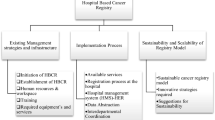Abstract
Electronic data sharing is a critical, but underappreciated, requirement for modern medical informatics systems. This capability is facilitated by acquisition of structured clinical data, but optimized only if this data is stored and transmitted using standardized representations. Most electronic medical record and clinical trials management systems are poorly suited for data sharing. In the near future, sharing clinical outcome data is likely to become very important, so these capabilities must be improved. In this article, basic concepts of electronic data sharing are reviewed and their use illustrated in a data-sharing project developed to support Hematopoietic Cell Transplantation reporting to a national database.

Similar content being viewed by others
References
Gelijns AC, Gabriel SE. Looking beyond translation—integrating clinical research with medical practice. N Engl J Med. 2012;366:18,1659–61.
Disclosure
No potential conflicts of interest relevant to this article were reported.
Author information
Authors and Affiliations
Corresponding author
Appendix: Glossary of Terms
Appendix: Glossary of Terms
- Structured data:
-
coded information such that its meaning is easily understood by a computer and not subject to each machine or user’s interpretation of meaning.
example: wbc = white blood count/microliter of whole blood
- Text:
-
information contained in a written word or sentence, not represented as structured data and therefore subject to each user’s interpretation with limited consistency and ability to aggregate content.
- Data sharing:
-
electronic transmission of coded information between computing systems without manual assistance
- Data standard:
-
a published form of a structured data element or aggregate that contains all the coding information required to electronically share the data between computing systems and across institutions. Ideally, this is shared widely within a field.
example: HL7 = Health level 7 standards for transmitting laboratory data
- Workflow:
-
computer screen views designed to match standard patterns of work or information interchange
- Module:
-
a computing construct or screen designed to support a discrete workflow process
- Interface:
-
a direct electronic connection between two or more computers through which data can be transmitted. Through a process called mapping, data can be exchanged between the systems even if shared data standards are not available. Without data standards, repetitive mapping between each unique pair of computers is often required.
- Domain-model database:
-
a database whose design is based on the data needs of a particular discipline or field.
example: BRIDG = domain model for clinical research
- Integration Engine:
-
a specialized interface supporting data sharing as well as specialized operations such as mathematical data manipulation, auditing of data flows, and data security.
- Back End:
-
the database behind a patient management application (program) that is a repository of the data. The “front end” consists in part of computer screens governing workflow and through which data is entered or viewed.
- Relational Database:
-
a database holding structures that define meaningful associations between groups of data.
example: defining the relationship between a laboratory result (wbc), the patient from whom the blood was obtained, and the date the blood was obtained
- Natural Language Processing:
-
using computer techniques to read text and convert selected information from the text to structured data.
Rights and permissions
About this article
Cite this article
Jones, R.B., Reeves, D. & Martinez, C.S. Overview of Electronic Data Sharing: Why, How, and Impact. Curr Oncol Rep 14, 486–493 (2012). https://doi.org/10.1007/s11912-012-0271-7
Published:
Issue Date:
DOI: https://doi.org/10.1007/s11912-012-0271-7




